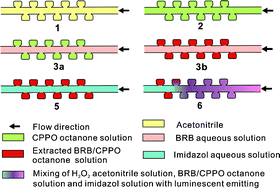A microfluidic chip based sequential injection system with trapped droplet liquid–liquid extraction and chemiluminescence detection†
Abstract
A microfluidic chip-based sequential injection system with trapped droplet liquid–liquid extraction preconcentration and chemiluminescence detection was developed for achieving high sensitivity with low reagent and sample consumption. The microfabricated glass lab-chip had a 35 mm long extraction channel, with 134 shrunken opening rectangular recesses (L 100 µm × W 50 µm × D 25 µm) arrayed within a 1 mm length on both sides of the middle section of the channel. Ketonic peroxyoxalate ester solution was filled in the recesses forming organic droplets, and keeping the aqueous sample solution flowing continuously in the extraction channel; analytes were transferred from the aqueous phase into the droplets through molecular diffusion. After liquid–liquid extraction preconcentration, catalyst and hydrogen peroxide solutions were introduced into the channel, and mixed with analytes and peroxyoxalate ester to emit chemiluminescence light. The performance of the system was tested using butyl rhodamine B, yielding a precision of 4% RSD (n = 5) and a detection limit of 10−9 M. Within a 17 min analytical cycle, the consumptions of sample and peroxyoxalate solutions were 2.7 µL and 160 nL, respectively.


 Please wait while we load your content...
Please wait while we load your content...